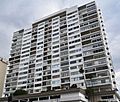Condominium facts for kids

A condominium, frequently shortened to condo, is a type of real estate divided into several units that are each separately owned.
Residential condominiums are frequently constructed as apartment buildings, but there had been an increase in the number of "detached condominiums" which look exactly like single-family homes but in which the yards, building exteriors, and streets are jointly owned and jointly maintained by a community association.
Unlike apartments, which are leased by their tenants, condominium units are owned outright. Additionally, the owners of the individual units also collectively own the common areas of the property, such as hallways, walkways, laundry rooms, etc.; as well as common utilities and amenities, such as the HVAC system, elevators, and so on. Many shopping malls are industrial condominia in which the individual retail and office spaces are owned by the businesses that occupy them while the common areas of the mall are collectively owned by all the business entities that own the individual spaces.
The common areas, amenities and utilities are managed collectively by the owners through their owners' association.
Scholars have traced the earliest known use of the condominium form of tenure to a document from first century Babylon.
The term "Condominium" is used throughout the United States and in most Canadian provinces. Strata title is used in the Canadian Province of British Columbia, as well as in Australia and New Zealand; while commonhold is used in the United Kingdom and the term used in South Africa is sectional title.
Italy uses condominio, which is simply the modern Italian form of condominium, which is Latin. Both condo and condominium are used colloquially in the Canadian Province of Quebec, where the official term is copropriété divise or "co-property devise" (the noun "devise," rather than the verb). In France, however, the term is simply copropriété, "co-property," and the common areas of these properties are usually managed by a Syndicat de copropriété or "co-property union" ("union" in the sense of "association").
Spanish-speaking nations and regions use the term propiedad horizontal, literally meaning "horizontal property" but abstractly meaning that all owners of the property are equal, on the same level.
Contents
Etymology
"Condominium" is a Latin word formed by adding the prefix con- ("together") to the word dominium ("domain, property, ownership"). Its meaning is therefore "shared property".
Condominia (the plural of condominium in Latin) originally referred to territories over which two or more sovereign powers shared joint dominion. This technique was frequently used to settle border disputes when multiple claimants could not agree on how to partition the disputed territory.
Overview
Mainly in the context of the United States
The difference between an "apartment" complex and condominium is purely legal. There is no way to differentiate a condominium from an apartment simply by looking at or visiting the building. What defines a condominium is the form of ownership. A building developed as a condominium (and sold in individual units to different owners) could actually be built at another location as an apartment building (the developers would retain ownership and rent individual units to different tenants). As a practical matter, builders tend to build condominiums to higher quality standards than apartment complexes because of the differences between the rental and sale markets.
Technically, a condominium is a collection of individual home units and common areas along with the land upon which they sit. Individual home ownership within a condominium is construed as ownership of only the air space confining the boundaries of the home. The boundaries of that space are specified by a legal document known as a Declaration, filed on record with the local governing authority. Typically, these boundaries will include the wall surrounding a condo, allowing the homeowner to make some interior modifications without impacting the common area. Anything outside this boundary is held in an undivided ownership interest by a corporation established at the time of the condominium's creation. The corporation holds this property in trust on behalf of the homeowners as a group—it may not have ownership itself.
Condominiums have conditions, covenants, and restrictions, and often additional rules that govern how the individual unit owners are to share the space.
It is also possible for a condominium to consist of single-family dwellings. There are also "detached condominiums" where homeowners do not maintain the exteriors of the dwellings, yards, etc. and "site condominiums" where the owner has more control and possibly ownership (as in a "whole lot" or "lot line" condominium) over the exterior appearance. These structures are preferred by some planned neighborhoods and gated communities.
Images for kids
-
The Cosmopolitan, a condominium in Singapore
-
The Luminary, a condominium in Tammela, Tampere, Finland
-
The interior of a loft condominium in Chicago's west side, USA
-
The Wilshire Regent condominiums in Los Angeles, California, U.S.
-
Aqua waterfront condominiums in Long Beach, California, U.S.
-
A historic mansion converted into condominiums in Chicago, U.S.
See also
 In Spanish: Condominio para niños
In Spanish: Condominio para niños









